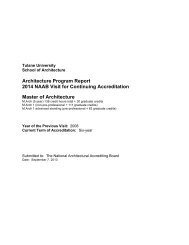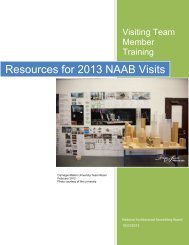Architecture Program Report Tulane University New Orleans ...
Architecture Program Report Tulane University New Orleans ...
Architecture Program Report Tulane University New Orleans ...
Create successful ePaper yourself
Turn your PDF publications into a flip-book with our unique Google optimized e-Paper software.
As a result of its new strength, the <strong>University</strong> was able to create the<br />
Department of Philosophy and Science, today the Graduate School, and<br />
initiate courses in architecture and engineering. In 1886, Josephine<br />
Louise <strong>New</strong>comb founded <strong>New</strong>comb College as a memorial to her<br />
daughter, Harriott Sophie. <strong>New</strong>comb was the first degree-granting<br />
women's college in the nation to be established as a coordinate division<br />
of a men's university. It became the model for other coordinate women's<br />
colleges, including Barnard and Radcliffe.<br />
<strong>New</strong>comb's founding is linked with the World's Industrial and Cotton<br />
Exposition, which opened in Audubon Park in 1884. Several artisans who<br />
came to the <strong>New</strong> <strong>Orleans</strong> Exposition to exhibit their own work and see<br />
the works of others stayed to establish the arts program, which was at<br />
the heart of <strong>New</strong>comb's early curriculum. By the early 1900s, <strong>New</strong>comb<br />
pottery had won a bronze medal at the Paris Exposition, its fame had<br />
spread across the nation, and young women were engaged in the<br />
unusual task of earning an independent living.<br />
In 1894, <strong>Tulane</strong> moved to its present campus on St. Charles Avenue, five<br />
miles by streetcar from its former site in downtown <strong>New</strong> <strong>Orleans</strong>. About<br />
the same time, the Richardson Memorial Building was built on Canal<br />
Street to house the medical school. Some medical classes were moved<br />
to the uptown campus, but clinical teaching remained downtown. The<br />
medical school was split between campuses until a major reorganization<br />
in the 1960s. For a quarter of a century, <strong>New</strong>comb College had been on<br />
Washington Avenue in the Garden District. In 1918 it, too, moved uptown<br />
to join other divisions of the <strong>University</strong>.<br />
Around the turn of the century, <strong>Tulane</strong>'s curriculum grew as several new<br />
professional schools were established, including the Deep South's first<br />
schools of architecture, business, and social work. City officials<br />
frequently consulted the College of Technology, now the School of<br />
Engineering, on construction techniques and soil conditions. Engineering<br />
alumnus A. Baldwin Wood designed the famous Wood screw pump that<br />
helps keep <strong>New</strong> <strong>Orleans</strong> dry. The first student yearbook, Jambalaya, and<br />
the first Tulanian were published. The Alumni Association was founded<br />
with 800 members, and significant contributions to the <strong>University</strong><br />
financed new buildings, library holdings, and research facilities. The<br />
Middle American Research Institute, founded in 1924, became a pioneer<br />
in Central American archaeology and anthropology, excavating and<br />
restoring the Mayan village of Dzibilchaltún in the Yucatan.<br />
Since then, research in many disciplines has flowered through the<br />
establishment of research centers, including: the Murphy Institute of<br />
Political Economy, the <strong>New</strong>comb College Center for Research on<br />
Women, the Roger Thayer Stone Center for Latin American Studies, the<br />
Center for Bioenvironmental Research, the <strong>Tulane</strong> Museum of Natural<br />
History, and the Amistad Research Center, curator of one of the largest<br />
collections in the world of primary source material on American ethnic<br />
groups, especially African-Americans. As early as the 1890s, <strong>Tulane</strong><br />
offered free lectures and classes to the <strong>New</strong> <strong>Orleans</strong> community. This<br />
commitment to community service was reaffirmed in 1942 with the<br />
founding of <strong>University</strong> College, which offers adult education and














